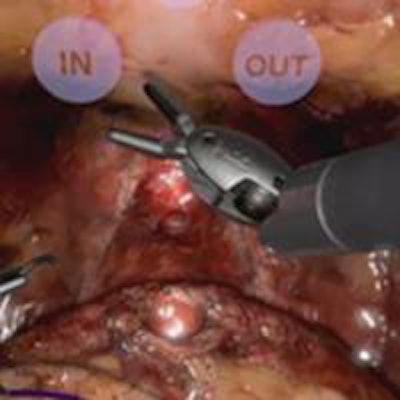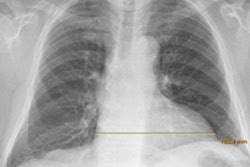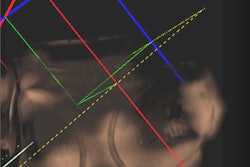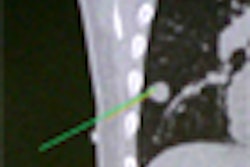
Researchers are simplifying the creation of virtual reality (VR) surgical training modules with the development of a task-based approach to simulations training, according to an article in the International Journal of Computer-Assisted Radiology and Surgery (IJCARS).
Inspired by videogame design, the module platform produces 3D virtual reality simulations that offer a realistic view of surgery -- in the case of this study, of urethrovesical anastomosis during radical prostatectomy. But the software can potentially be executed for any robotic surgery platform.
"The modular methodology presented here can be easily extended to support more complex tasks," noted study authors Yaki Setty, PhD, from D Systems Healthcare in Israel, and Oren Salzman, a doctoral student from Tel Aviv University. "We foresee this methodology as a tool used to integrate [procedure-specific simulations training] (PSS) as a complementary training process for surgical procedures." (IJCARS, 4 July 2016).
The modules are commercially available as part of the Robotix Mentor product line, and "in the future could possibly be included in the customized package of Intuitive Surgical DaVinci Skill Simulator," Setty told AuntMinnieEurope.com.
 Using the RobotiX Mentor training module. Image courtesy of Yaki Setty.
Using the RobotiX Mentor training module. Image courtesy of Yaki Setty.The virtual-reality simulations for minimally invasive laparoscopic surgery are typically designed to mimic a series of simulated tasks. These are derived from physical models, and used to train fundamental surgical skills, the authors explained.
Trainees can hone technical skills such as hand-eye coordination and tool manipulation needed to perform laparoscopic surgery. The simulations have been validated clinically and shown to improve surgeons' performance.
The modules belong to a new type of learning tool known as procedure-specific simulation (PSS). PSS is a kind of 3D-interactive computer-based simulation that replicates an entire surgical procedure realistically while providing educational feedback and performance metrics.
PSS aims for more than simple tasks, and must support a wide array of elementary actions and a varied combination of skills that deliver a successful surgical procedure, they wrote. But the PSS genre is still in its infancy. "In particular, there are no existing standards or guidelines laid out for developing PSS in a structured manner," they noted.
Building a training module
To develop such a process, the article presents a task-based methodological approach to using urethrovesical anastomosis during radical prostatectomy, noting three steps required for PSS, including
- Identify tasks which familiarize users with the surgical environment and key anatomic structures
- Guided tasks to train users on a specific technique
- Freehand tasks that enable the testing of complete procedural techniques, enabling trainees to experience a variety of complication scenarios
Two types of visual instructions guide the user: guidance objects on specific areas of the tissues and, second, text messages on a screen. The guidance objects direct the user to a specific area on the tissue, while the text messages provide general instruction regarding the required action, Setty wrote.
For example, to show the user where to perform a stitch, "we place a sphere to designate the target point on the relevant area of the tissue," the group stated. "[A]n arrow indicates the desirable sewing direction. Initially, the target point is colored yellow, but it turns green if accurately punctured with the needle and red otherwise."
During this process, text messages direct the user regarding the next step or give notification if the taken step conflicts with the technique guideline.
Tasks are graded from basic to advanced corresponding to the skill levels of trainees. Identification tasks used to familiarize trainees with anatomy are placed on the left side of the chart while freehand tasks that let users practice complications and advanced techniques are placed to the right. In the middle are guided tasks that suit intermediate trainees who practice procedures using known techniques.
Radical prostatectomy consists of several steps that include dissecting and transecting the bladder neck and the urethra, removing the prostate and performing the urethrovesical anastomosis which reconnects the two branches of the urethra, the group wrote.
Rather than open surgery, the laparoscopic approach makes use of surgical tools and a camera inserted through several small incisions across the belly, with radical prostatectomy performed from outside the body, the team wrote. The newest technique provides robotic assistance in which the surgeon performs the operation while sitting at a specialized console that controls a set of articulated surgery tools that replicate natural wrist movements accompanied by a 3D stereo display.
The simulation for this project realistically displays the anatomy within the pelvis after the prostate was dissected and removed, leaving the urethra branched. The surgeon then reconnects the two tissues to allow normal urination by sewing the bladder neck peripheries with the urethra.
 Simulated robotic radical prostatectomy, freehand urethrovesical anastomosis performed on a RobotiX Mentor console (Simbionix). YouTube videos of surgery are available here, here, and here.
Simulated robotic radical prostatectomy, freehand urethrovesical anastomosis performed on a RobotiX Mentor console (Simbionix). YouTube videos of surgery are available here, here, and here.The simulations are based on videogame design that supports stereovision, and can be executed on any robotic surgery platform. This simulation was tested in a Windows environment on the RobotiX Mentor educational product (shown here) and designed for surgeons to practice their robotic surgery skills. MentorLearn courseware provides metrics and benchmark feedback for the simulation, including task length and tool manipulation efficiency, as well as the accuracy of suturing for the urethrovesical anatomists.
Beginners can train independently on the courseware and test their skills on a variety of surgical complications. They can practice with a variety of surgical techniques on either guided or freehand tasks, the authors explained. Instructors can monitor students' progress, focusing the training on individual areas in which the trainee needs attention.
The developers solicited advice from surgeons worldwide on module plausibility and realism, the group wrote. All of the surgeons practiced on the module and offered feedback for improving it. The module is undergoing validation studies to examine its teaching value on a broad user audience. The authors see their methodology becoming a standard for PSS training.
"The main subject in this module is the suturing technique," Setty wrote in an email. "Guided training follows a specific technique which is quite common in the surgical community, but not necessarily optimal."
By repeatedly practicing the technique, Surgeons improve their efficiency while gaining a better understanding of its advantages and limitations as compared with other methodologies.
"Broadly speaking, it is among the most advanced and realistic medical virtual reality simulations in the market today," Setty told AuntMinnieEurope.com.
Much effort was put into fine-tuning the graphics to best recreate the look of the real- world procedure. Complex algorithms allow the physical behavior of the tissue, suture, and tools to accurately mimic their real world motion.
"The best litmus test is the feedback from real surgeons," Setty stated. "In many cases, surgeons told us that they found the simulation so realistic that they felt as if they were operating on an actual patient."
The task-based approach to PSS training is built on concepts that were introduced in some existing simulations, Setty and Salzman wrote. This project extends and generalizes the method, "providing a conceptually clear and structured methodology" they added. "We believe that the presented methodology can be easily implemented in a broad spectrum of PSS."
The group has already applied its methodological approach to two other prostatectomy-related tasks: bladder neck dissection and neurovascular bundle-sparing PSS, Setty told AuntMinnieEurope.com. "The approach was also implemented in Robotic Inguinal Hernia PSS and is being considered for future versions of hysterectomy and lobectomy PSS," he added.



















